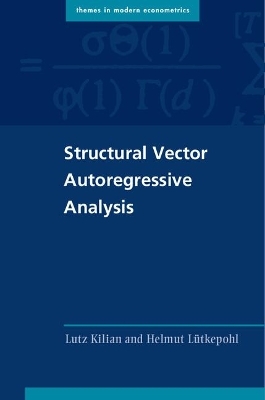
Structural Vector Autoregressive Analysis
Cambridge University Press (Verlag)
978-1-107-19657-5 (ISBN)
Structural vector autoregressive (VAR) models are important tools for empirical work in macroeconomics, finance, and related fields. This book not only reviews the many alternative structural VAR approaches discussed in the literature, but also highlights their pros and cons in practice. It provides guidance to empirical researchers as to the most appropriate modeling choices, methods of estimating, and evaluating structural VAR models. The book traces the evolution of the structural VAR methodology and contrasts it with other common methodologies, including dynamic stochastic general equilibrium (DSGE) models. It is intended as a bridge between the often quite technical econometric literature on structural VAR modeling and the needs of empirical researchers. The focus is not on providing the most rigorous theoretical arguments, but on enhancing the reader's understanding of the methods in question and their assumptions. Empirical examples are provided for illustration.
Lutz Kilian is Professor of Economics at the University of Michigan, Ann Arbor. Between 2001 and 2003 he served as an adviser to the European Central Bank in Frankfurt am Main, Germany. Professor Kilian has been a research visitor at the Federal Reserve Board, the Bank of Canada, the European Central Bank, and the International Monetary Fund. His work has appeared in Econometrica, the American Economic Review, and the Journal of Political Economy. He has served as associate editor of the Journal of Business and Economic Statistics, among other journals. Helmut Lütkepohl has held professorial positions at Universität Hamburg, the Christian-Albrechts-Universität zu Kiel, Germany, the Humboldt-Universität zu Berlin, the European University Institute, Florence, and the Freie Universität Berlin. He has served as Dean of the Graduate Center of the Deutsches Institut für Wirtschaftsforschung, Berlin. He has published professional articles in Econometrica, the Journal of Econometrics, the Journal of Business and Economic Statistics, Econometric Theory, and the Journal of Applied Econometrics. He has also served as associate editor of the Journal of Econometrics, Econometric Theory, Macroeconomic Dynamics, the Journal of Applied Econometrics, and Econometric Reviews. He is the author of New Introduction to Multiple Time Series Analysis (2010).
1. Introduction; 2. Vector autoregressive models; 3. Vector error correction models; 4. Structural VAR tools; 5. Bayesian VAR analysis; 6. The relationship between VAR models and other macroeconometric models; 7. A historical perspective on causal inference in macroeconometrics; 8. Identification by short-run restrictions; 9. Estimation subject to short-run restrictions; 10. Identification by long-run restrictions; 11. Estimation subject to long-run restrictions; 12. Inference in models identified by short-run or long-run restrictions; 13. Identification by sign restrictions; 14. Identification by heteroskedasticity or non-gaussianity; 15. Identification based on extraneous data; 16. Structural VAR analysis in a data-rich environment; 17. Nonfundamental shocks; 18. Nonlinear structural VAR models; 19. Practical issues related to trends, seasonality, and structural change; References; Index.
| Erscheinungsdatum | 16.01.2018 |
|---|---|
| Reihe/Serie | Themes in Modern Econometrics |
| Zusatzinfo | Worked examples or Exercises; 40 Line drawings, black and white |
| Verlagsort | Cambridge |
| Sprache | englisch |
| Maße | 157 x 235 mm |
| Gewicht | 1140 g |
| Themenwelt | Wirtschaft ► Volkswirtschaftslehre ► Ökonometrie |
| ISBN-10 | 1-107-19657-4 / 1107196574 |
| ISBN-13 | 978-1-107-19657-5 / 9781107196575 |
| Zustand | Neuware |
| Haben Sie eine Frage zum Produkt? |
aus dem Bereich


